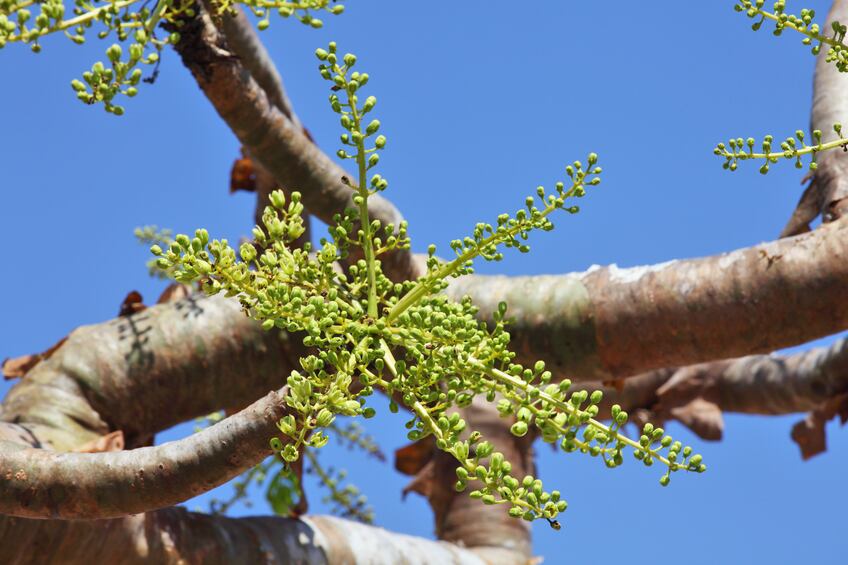The review paper was published in the Journal of Ethnopharmacology. Botanical consultant Thomas Brendler, PhD, the lead author, was joined by Josef Brinckmann, PhD of Traditional Medicinals and Uwe Schippmann, PhD, of the plant conservation division of Germany’s federal environmental protection office (Bundesamt für Naturschutz).
Slow growing tree species
In the paper, titled “Sustainable supply, a foundation for natural product development: The case of Indian frankincense (Boswellia serrata Roxb. ex Colebr.)”, the trio looked at available market information for the trade in the botanical. Boswellia serrata is a deciduous tree native to the Indian subcontinent, Sri Lanka, and other areas of southeast Asia such as the Arabian peninsula. Closely related species, some of which are potentially interchangeable from an ethnopharmacological point of view, can be found in areas of eastern Africa
Boswellia has been an important ingredient in Ayurvedic preparations for many centuries. It is noted for its anti inflammatory effects and has been used in herbal medicines aimed at arthritis and other kinds of joint pain, ulcerative colitis and even cancer.
The raw material for these preparations was traditionally gathered as a resin exudate from the trunks of the Boswellia serrata trees. In order to boost production, trees are often tapped for sap in a similar fashion to how maples are tapped for sugar in eastern North America.
Presumably the greatest consumption of Boswellia exudate is within India itself. In the trade information the authors evaluated, Trinidad and Tobago was the largest importer of raw material (as a former part of the British Empire, that country has a large Indian population). Other importers in order are Germany, Guatemala, Mexico and the United States.
The authors included tonnage data for two years, a small sample which would point to a widely fluctuating trade in this botanical. “Total volumes exported were 102.8 metric tonnes in 2015–2016 and 74.56 metric tonnes in 2016–2017,” they said.
Demand ramps up
According to the authors, some sources say the tree is now classified as “rare” in India, while others find that it fairly widely distributed in woodlands south of the Ganges Valley. But like some other botanical raw material sources, the supply cannot realistically be ramped up to meet rapidly increasing market demands.
“The original setup was pretty much to feed the national demand and then Western herbal medicine started picking it up and boswellic acid became a big thing,” Brendler told NutraIngredients-USA.
The tree is a slow grower, and the authors said the longstanding practice of tapping older trees for resin can reduce the already paltry fruit set, meaning few seeds are produced to start the next generation of trees. Some areas appear to have a healthy ratio of younger trees even so, so immediate extinction is not a concern. But with the population pressure in India, the country’s woodlands, while still surprisingly extensive, are shrinking, as more farmers and herders are pushed into marginal areas.
“I have been following the Boswellia story for some time,” Brendler said. “This goes back to when we put together a monograph for the African species. That came about because people were asking after the African sources, and that raised some red flags. That was probably ten years or more ago.”
Habit loss threatens supplies
Brendler said the current paper grew out of project looking at which species of pharmacological interest around the world might be considered for CITIES listings (Convention on the International Trade in Endangered Species).
“We looked at all of the Boswellia commodities. In terms of the trade, they are all interconnected,” he said.
“We are looking at a shortage of B. serrata,” Brendler said. “These trees have been subjected to unsustainable harvests. The supplies are threatened by habit change and other human interference.”
The primary active constituents in Boswellia are a series of boswellic acids. While the serrata species is the primary source, some of the other species exhibit these in acceptable quantities, too, Brendler said.
“You can substitute with Boswellia carterii, if you do it properly. But over the years some of the raw material has been substituted in with some of the other African species so that it is hard to know what’s what,” he said.
A recent paper reported on in NutraIngredients-USA noted the botanical is subject to adulteration.
There is hope for the future of these species, Brendler said. There is a project getting off the ground to cultivate the trees in Somaliland, the quasi-independent northern portion of war-torn country of Somalia. And the Indian government has plant protection regulations in place, though Brendler said there is not enough information to evaluate the effectiveness of these on a district-by-district level.
For info needed for CITIES recommendation
In the end, Brendler said he and his coauthors were not able to make an informed recommendation about the question of the CITIES listings. For the primary raw material, more information is needed.
“Published research on B. serrata is still scant and compounded by the regionality of existing assessments and lack of specific production, processing and trade data. More comprehensive assessments are needed to fully and conclusively evaluate the ecological status of the species and the sustainability of current management practices,” the authors concluded.
Source: Journal of Ethnopharmacology
2018 Oct 28;225:279-286. doi: 10.1016/j.jep.2018.07.017. Epub 2018 Jul 18.
Authors: Brendler T, Brinckmann JA, Schippmann U

